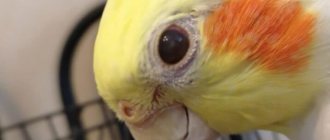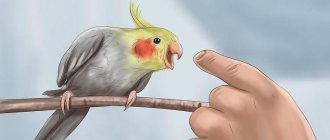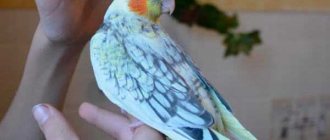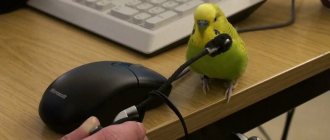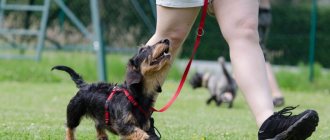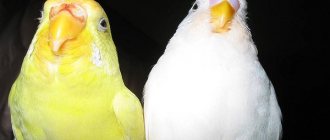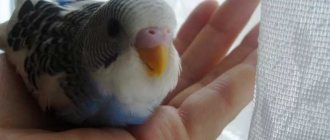Parrots are the only species of birds capable of remembering and reproducing human speech. Thanks to this feature, they are very popular among poultry lovers. But we must remember that their speech skills are not innate, but are acquired in the process of long-term training. In our article we will try to answer the question of how to teach a parrot to speak.
At what age is it better to learn to speak?
When deciding how to teach a budgerigar, cockatiel, gray parrot or other species to speak, you should always remember that young birds are more amenable to speech training. Teaching an adult parrot to speak words may not work. The optimal age for starting training is different for different types of parrots.
Budgerigars can be trained at 30-45 days of age. After 3-4 months of painstaking work, results can be obtained. The ideal age for training a cockatiel is 4-9 months. He learns faster than the wavy ones.
Gray parrots can begin to be trained in the age range of 3 to 9 months. By the way, this is the most capable representative of the entire extended family for learning speech. True, keeping it at home is more difficult than cockatiels or wavy birds.
What types of parrots learn faster?
The fastest-learning varieties of parrots include:
- Amazon. Experts believe that these birds learn spoken language faster than all other large representatives of the family. They are able to remember and reproduce 50-60 words.
- Budgerigars are the fastest learning small species. Vocabulary is often limited to 10-20 words, pronunciation is unclear.
- Corella. Talking cockatiels are very popular among bird lovers. On average, their vocabulary reaches several dozen words.
- Macaw. The vocabulary is very low - up to 20 words. But scientists have found that macaws are the smartest of the parrots. They are able to connect words and events, build an associative chain of thinking.
- Cockatoo. Speech training of representatives of this genus leads to the fact that birds begin to pronounce words well and legibly. Their vocabulary can include up to several dozen words.
- Jaco. If a bird lover wants to get a 100% talking parrot, then this is the choice for him. These birds are distinguished by the most developed speech abilities of all members of the family. They can remember and reproduce over 100 words and speak in phrases. The intellectual level of the Gray Gray is very high and corresponds to the level of a five-year-old child.
Does a parrot's gender affect its ability to speak?
There is a statement that female parrots learn to speak less well than male parrots. There is some truth in this, since girls' speaking skills are a bit limited.
But if you set yourself a goal, you can teach a girl to speak a parrot, then the spoken words will be much clearer than those of boys.
There are no particular differences in training feathered boys and girls, you just need to spend much more time teaching girls to speak.
Which parrots talk the best?
- Jaco is a smart, fairly calm pet. If a bird is taught to speak intensively and efficiently, the bird will become a well-mannered friend with excellent conversational abilities. They have a penchant for self-learning.
- Amazon, easy to learn and a talker from God. Some of its individuals are capable of learning more than 100 words. If you were looking for a bird with such data, then this species would be an excellent option.
- The wavy pet is a talkative bird, capable of remembering and speaking individual words. The quality of reproduction is not very good, but if the bird is trained more often, this will change.
The variety of species is undoubtedly very great, but there are still absolute record holders, such as Jaco, this is the only parrot that is easiest to teach to speak. Birds are very intelligent; they remember words, phrases, phrases and even entire sentences faster than others. Voices, sounds, and music are perfectly and accurately portrayed. Well-trained Jacos can not only pronounce learned words and phrases, but also carry on a conversation.
Who is more capable - males or females?
Many years of practical experiments and observations show that males learn to speak faster than females and have a larger vocabulary. This is due to the fact that their vocal cords are much more developed. In the wild, boys have to sing quite often, including during mating games. So, if a person wants to buy a parrot that will speak well, he should focus on the gender of the bird he is purchasing.
But speech training of females is not at all a hopeless task. Despite the fact that girls study longer and have a smaller vocabulary, they pronounce words much more clearly. So you don’t have to think long about whether it is possible to teach a female budgerigar to speak. We need to start the process.
Can a budgie learn to say words in 1 day of training?
The most easily trained talkers are the Gray and Macaw parrots. Teaching budgerigars to speak is noticeably more difficult. It will take a lot of time and will require patience and diligence from the teacher. The first word spoken by the wavy is preceded by numerous hard trainings.
Training a feathered pet takes on average 3–5 months. At the same time, in order for the parrot to speak, classes with the bird must be regular throughout the entire period of training. This requires a certain discipline and punctuality from the owner.
The exact time when budgerigars begin to speak is impossible to determine. Each bird is unique and inimitable, each has different abilities, and therefore they achieve different levels of success in learning. One wavy learns faster, the other slower. But still, we have not yet encountered any brilliant birds who spoke before 2-3 months of training. Therefore, the answer to the frequent question whether it is possible to teach a wavy to speak in 1 day is a firm “no.”
The key to fast and high-quality training
When solving the question of how to teach a parrot to talk in practice, you must adhere to some rules, otherwise the result of the process will be negative.
Regular classes
To teach your pet to speak, you need to work with it systematically. Lessons should take place every day and take approximately 15-25 minutes. Once a week you can conduct a kind of control session lasting 35-45 minutes.
Insulation
Experts recommend isolating a parrot whose owner wants to teach him to speak. Neighbors in the cage make it difficult to concentrate and distract the bird’s attention during lessons. Some experts recommend removing unnecessary toys and accessories from the cage.
Nothing should distract the pet's attention from activities, otherwise achieving the goal is not guaranteed.
No stress
The atmosphere during classes should be calm and friendly. The bird should not be afraid of anything, otherwise a good result may not be expected. Therefore, you can only train parrots that have already adapted to their living conditions.
It is worth mentioning separately:
- Inadmissibility of punishment. Their use will have the completely opposite effect.
- The need to conduct a lesson only in a good mood. Birds feel the emotions of their owners. A person’s manifestation of irritability will not go unnoticed. Psychological contact with a feathered pupil can be hopelessly damaged.
Motivation
Motivation is extremely important in the learning process. You can achieve a positive attitude in your parrot and a desire to learn new words by giving him a treat every time after successfully completing a task.
Patience
Patience and work will grind everything down, says a Russian folk proverb. This fully applies to the training of parrots. The person handling the bird should not try to force things too much. He should not abandon the process after the pet’s first failures. All difficulties will be overcome after persistent and systematic work.
We continue to teach Volnistik conversation
During training, you need to pay attention to your intonation. Birds perfectly sense a person's mood. So, you need to talk to birds emotionally (kindly, kindly), but not shout - this will scare away the parrot. And monotonous speech can quickly get boring for them.
It is worth paying attention to the reaction of a budgie to certain words. If he gets worried, starts running fussily from side to side, or reacts in some other way, then this word is like a signal. It is better not to say it again during training.
Exercises with budgies should be enjoyed. Organize activities in the form of a conversation, that is, treat your pet as if you were a small child.
It is necessary to pronounce a word or phrase at least ten times during the entire lesson, but do not mindlessly jabber. You always need to maintain emotional intonation so that the parrot is interested in listening. The parrot expresses its interest by its attentive gaze, following you during training, and by fluffing its feathers.
It is important to notice the budgerigar's attempts to speak and reward his efforts with some kind of treat. This will encourage the bird to repeat the learned word over and over again. At first, the wavy will simply open its beak, watching you speak. Then he will try to repeat the sound that he heard from you earlier.
You cannot scold a bird when it fails or is simply silent. Patience is important in training, and such emotional outbursts will only further push the bird away from classes and the desire to speak.
In order for a budgerigar to learn to say, for example, the word “delicious” when feeding, you need to repeat this word exactly when you put food in the feeder. If you want your feathered pet to say other phrases, in other situations you must also repeat those words that you would like to hear from the parrot later.
Budgerigars that have already learned to speak several words tend to form new words by swapping syllables in one word or syllables in different words. For example, from the phrase “Roma, hello,” the parrot comes out “roaring.”
It is worth noting that parrots remember rhyme well. Try to choose a rhyme in the form of a simple word for each word that you want to teach your pet.
Of course, live communication with a parrot during classes is effective, but in some cases, machine reproduction of your voice is also useful. For example, a voice recording can help if you are away from home for a long time. After all, training with a parrot should only be carried out by one person whom the bird trusts.
How to teach a parrot to pronounce sounds clearly
When training a budgerigar, you may encounter the fact that the bird speaks unclearly. The same problem exists in other species. There are two reasons for its occurrence:
- The teacher himself has unclear pronunciation. In this case, he needs to think about how to adjust his diction.
- Lack of speech practice in birds. In this situation, you need to think about how best to organize activities with your pet.
Patience and hard work by the trainer with the pet and on himself will definitely lead to a positive result.
Funny phrases from budgies that will cheer you up
A parrot is an entertaining bird in itself, and if it also says something funny or amusing, a good mood is guaranteed. Come up with and teach your pet some phrases that will be interesting to hear for both you and your guests. For example, when it sees its owner in the morning, a bird may shout: “My little bunny, can I give you some coffee?”, or: “Come and give me a kiss!”
You can expand your pet’s repertoire with “winged” sayings from the famous cartoon about Kesha:
“What am I wearing? In rags, like Cinderella!”
“Well, after this rain, expect a good calving”
"Freedom for parrots!"
If there is a cat in the house, you can teach your parrot to scream when he approaches, “get the animal away,” or “let the cat eat.” Some phrases can even be useful, for example, a parrot will remind its owner “Did you turn off the iron?”, “Buy some bread!” or: “Stop eating, watch your figure!”
Taking good care of your budgie, treating it affectionately and regularly exercising it will allow you to soon acquire a true friend. And provided that the pet’s vocabulary is constantly updated, an inquisitive little bird can become a funny and restless interlocutor not only for you, but also for your guests.
Errors in learning
- Unsystematic activities. Irregular lessons do not bring the desired result, but lead to disappointment. The bird simply does not remember the material taught to it. Speech abilities simply do not develop with such an organization of classes.
- Conducting a lesson in a bad mood. This leads to psychological breakdowns in the teacher, which leads to stress for the parrot and loss of contact with him. And without contact with the student, no educational process is possible. It will simply turn into torment for both the teacher and the student.
- Use of punishments. The bird simply does not understand their meaning and they are interpreted as hostile actions. The result is rejection from the person. The planned result is unlikely to be fully achieved.
How long does a budgie remember learned phrases?
Parrots have a very good memory, especially in their youth, and the bird will never forget phrases learned in the first year of life. Although, if you do not periodically repeat the material covered, the clarity of pronunciation will suffer, or the parrot will begin to mix the letters with bird chirping.
Often parrots stop talking when another individual moves in with them, and the couple begins chatting among themselves in their own language. Don’t assume that your pet has forgotten everything in joy.
Usually, such “family” parrots remember the phrases they have learned, they simply limit their use for a while, and there is no need to stop practicing.
